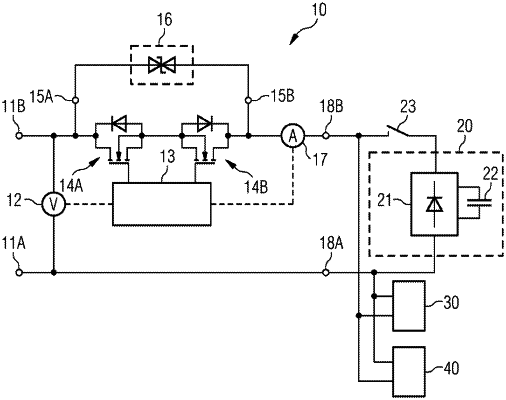| CPC H03K 17/0822 (2013.01) [H02H 9/001 (2013.01); H03K 2217/0009 (2013.01)] | 12 Claims |

|
1. A method for actuating a power semiconductor switch of an AC circuit that can be activated or deactivated by the power semiconductor switch, the method comprising:
a) ascertaining a present current value and a present voltage value of the AC circuit;
b) ascertaining whether the present current value exceeds a specifiable maximum value and if so,
c1) generating a deactivation signal for deactivating the circuit;
c2) generating an actuation signal for activating the circuit within a period of time after generating the deactivation signal for deactivating the circuit, wherein the period of time is less than or equal to the period of the voltage;
c3) ascertaining whether the present current value exceeds a next specifiable maximum value, which corresponds to the previous maximum value or is less than the previous maximum value, after activating the circuit, and either
c4a) ascertaining whether a current/time profile at least approximately corresponds to an expected current/time profile of a short circuit immediately before and immediately after the next zero crossing of the present voltage value, or
c4b) ascertaining whether the current/time profile does not at least approximately correspond to an expected current/time profile immediately before and immediately after the next zero crossing of the present voltage value, and
c5) repeating steps c1), c2), c3), c4a) or c4b), and c5) if the condition of step c3) is met and the condition of step c4a) is not met or the condition of step c4b) is not met;
d) identifying a fault case and permanently outputting the deactivation signal in order to disconnect the circuit, and terminating the method if the number of repetitions of steps c1), c2), c3), c4a) or c4b), c5) exceeds a value n and/or if the condition c4a or c4b is met;
e) continuing to generate the actuation signal for activating the circuit if it was ascertained in step b) that the present current value undershoots the specifiable maximum value or if it was ascertained in step c5) that the condition of step c3) is not met, and continuing the method with step a).
|